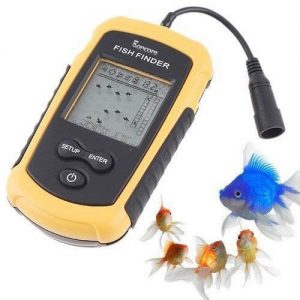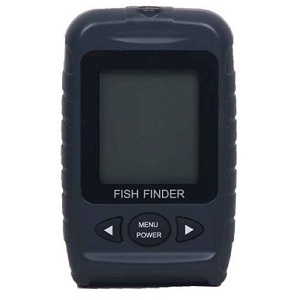Affordable fish finder – Buying guide, Reviews & Comparison
If you want to find the best fishing gear, but you don’t have time to go through the buying tips and reviews prepared by our research team, this short paragraph should tell you everything you need to know about the best cheap fish finders out there. After analyzing a lot of feedback coming from both amateur and professional fishermen, we have concluded that the Garmin Echo 151dv is the best because it’s affordable, comes with a dual-beam transducer, and can offer readings up to 1,600 feet in water depth. Therefore, there are many purposes for which you can use this device, in that you can use it both in shallow waters and even in the ocean. Additionally, we’ve noticed that most of the people who have purchased have only good things to say about its performance and easy interface. If the Garmin Echo 151dv is unavailable, you should consider the Venterior Portable as it is a reliable alternative in terms of performance and quality.
Comparison table:
 Our Top Choice
Our Top Choice
The Garmin Echo 151dv seems to be one of the top cheap fish finders available on the market today. It’s packed with a dual-beam transducer and can provide readings of up to 1,600 feet, which means that you’ll even be able to fish in the ocean with the help of this device. Besides, the swivel mount and quick-release tilt are part of the deal with this product.
When the fish finder is turned on, it needs about two to three minutes to start displaying the depth info.
Affordability doesn’t get better than this. This model is among the critically acclaimed choices if you’re willing to settle for a grayscale screen.
 2nd Best
2nd Best

Since the screen of this affordable option is backlit, it can mean the world for an angler who likes to fish both during the day and during the night. Since the operating temperatures of the Venterior are generous, it can also be used for ice fishing. The product is easy to handle and compact and makes it a breeze for beginners to locate their catches.
The cable might be a nuisance if you want to use the device in your kayak, as it measures 7.5 feet in length.
Since this fish finder is not based on the traditional arch interface currently used in many other options, it takes the cake when it comes to usability.
Also To Consider

Because it costs just under forty dollars, the Eoncore Portable might just as well be the cheapest fish finder. However, the unit offers plenty of value as it comes with a backlit display and is fairly easy to install and utilize. Besides, if offers accurate and efficient readings, therefore allowing you rest assured that you will never miss a catch. A neck strap can also be found in the box.
Since the screen is not waterproof, prospective buyers have to purchase a separate transparent cover.
If your skills just need a little boost, you’re more than free to check out the specs of this model. It’s high-quality and comes with user-friendly functions.
3 Best Cheap Fish Finders (Reviews) in 2024
That fishing trip you’ve been planning with your buddies may yet establish you as the king of the lake if you bring along a powerful but inexpensive fish finder. One can easily find a good device with diligent research and reading. However, if you`d rather focus on practicing your fishing moves than sit down and scour the many pages of fishing websites, let us make things easier by recommending three fantastic products you can choose from.
1. Garmin Echo 151dv US and Canada with Transducer

The difference lies in the current device`s upgrades that include the DownVu, which is its down imaging capability. DownVu offers viewing of more details such as individual fish within a structure or swimming with a school. It increases the accuracy level of readings from about 40 feet and deeper.
The device also offers support for a separately purchased 50/200 kHz dual frequency transducer. Providing a power output of 200 watts RMS, along with 1600 watts peak-to-peak, the fish finder has a maximum depth capacity of 1600 feet.
The viewing cone graduates from narrow to wide so the angler can see images far beyond the sides of the boat, ranging from shallow to maximum depths. The split-screen feature allows side-by-side viewing of the traditional sonar and down image, with superb target separation and bottom tracking.
Pros
You will get more than a standard fish finder when you purchase this model, as its all-in-one transducer will offer you an almost photographic view of schools of fish.
The 8-level display lets you understand precisely how the fish moves and you can track what it happens underneath your boat and further with excellent efficiency.
You can extend your vision beyond just what takes place under your boat, as the sonar goes as far as 1,600 feet deep.
The tilt and swivel mount will come in handy and will prove very convenient when you want to employ the fish finder in one spot so that you can see about your fishing.
The display resolution is 160×256, giving you quite a clear picture of the fish.
Cons
You will have to wait a little while for the fish finder to start displaying readings, which can be a drawback, especially if you are not the most patient person.
Buy from Amazon.com
2. Venterior VT-FF001 Portable Fish Finder Handheld Fishfinder

Giving users the approximate location of fish, along with the depth of the water, this portable fish finder is equipped with a round transducer sensor that sends out sonar waves into the water. The sonar signal bounces off of objects under the boat and gets transmitted back to the device for immediate viewing as an image on the screen. Conveniently, the transducer comes with a 7.5-meter cable for stable power.
The Venterior Portable Wired Fish Finder offers a 45-degree beam angle that finds large submerged structure as well as fish, enabling users to zero in on the target in order to capture it more easily.
The device provides fish depth scale and is equipped with an audible fish alarm so the angler always knows where to find target fish. It even has a power saving feature that turns the unit off when not in use.
Pros
You will get a very accurate reading of what is happening in the water, and not only fish location, but also the placement of weeds, rocks, and other things on the bottom of the water body.
The transducer comes with a 25-foot cable, and the float can be removed; you can successfully use this device when fishing from your boat, when you go ice fishing, or even when fishing off a dock.
The depth range goes from one meter to 100 meters, but you must keep in mind that the depth is calculated from the sonar sensor and not the transducer’s float.
You can select sensitivity from 5 available settings, which gives you more control over what type of fish you want to monitor.
Cons
One issue that must be mentioned about this model is that the setting preferences do not remain saved after the unit shuts off.
Buy from Amazon.com
3. Eoncore Portable LCD display with LED Back-Lighting

The unit offers plenty of advantages. On the one hand, it can be used by beginners without needing them to bother to understand the complicated arch graphics featured by most fish finders out there. On the other hand, the product comes with a transducer of which the maximum depth capability is 328 feet.
The cable the Eoncore Portable is equipped with measures 7.5 meters, which means that this option is highly recommended for people with larger boats particularly when compared to kayaks. Since the screen isn’t waterproof, it might be a good idea to use some kind of transparent cover so that the water doesn’t affect the operation of the device.
The Eoncore Portable is a rather versatile product that does what it’s supposed to do regardless of the environment temperature given that it’s entirely capable of operating from -4 to 158 degrees Fahrenheit.
As for the owner feedback, it looks as if most of the people who took the time to review the product have nothing but good things to say about it. It’s durable, convenient, and offers accurate readings.
Pros
The fish finder will display the body of water, with grass, weeds, rocks, and sand so that you can see the fish from all the rest.
The device is capable of identifying the fish location and will calculate the depth of water, too, offering you the best information for catching fish like a pro.
It can read depths from 0.7 meters to 100 meters, offering you a broad range of possibilities, no matter what kind of fish you want to catch.
The audible alarm is an extra feature that will let you know as soon as the unit detects fish moving in the water.
You can select between reading the depth in meters or feet.
Cons
Lack of proper instructions may make the initial learning curve a bit steep, as some buyers notice and comment in their reviews.
Buy from Amazon.com
Buying guide
Whether you get a really pricey unit or one of those cheap fish finders out on the market, you have to make sure the device you have will help you catch the most fish. If you’re serious about fishing, you can’t afford too many missed opportunities just because you own a really lousy fish finder. Here’s what to check out in this kind of equipment.
Transducer
Any self-respecting angler knows that even cheap fish finders should be equipped with a transducer. The transducer is the primary unit that emits and receives sonar waves, sending the sonar signal into the water. The signal then bounces off of underwater objects and gets picked up by the transducer. The data picked up through the device will be ìnterpreted as a picture that the user can see and understand.
Some models serve as all-in-one transducers that provide advanced high definition identification plus a scanning sonar to deliver a virtually photographic view of the structure and fish under the water craft. Others have a round transducer sensor that also does the same.
Frequency
The frequency is a huge factor in any transducer. Plenty of the best fish finder models come with 200 kHz frequencies, and sometimes 50, 83 and 192 kHz, all in direct relation to the cone angle.
While the higher frequencies such as 192 and 200 kHz are designed for optimal use in shallow water, low khZ devices such as 50 kHz provide superb fish finding capability in deep water. With higher frequency, a greater degree of detail can be detected and viewed on the display panel, thanks to the high number of sonar waves transmitted and received.
Cone Angle
The width of the beam sent from the bottom of the boat into the water is referred to as the cone angle. A larger area is covered when the degree of the cone is wider. Keep in mind that the sensitivity is inversely proportional to the width of the angle especially in deep water. Typically, transducer cones come in ranges between 9 degrees and more than 60 degrees, with most devices equipped with ranges from 16 to 20 degrees.
» Check the information from past years
Unavailable products
Signstek FF-009

This model offers user-selectable depth range so users can fish where they want. The zoom on/off feature enables the user to have higher focusing levels when needed. One can choose between meter or feet readings for customized usage.
The device is equipped with a powerful 200 kHz sonar that transmits waves into the water, which gets bounced off of objects underwater for easy interpretation as images on the display screen.
The fish finder provides depth readings from 2.0 to 240 feet with 1/10th precision, making it easy to fish accurately whether in shallow or deep water. It comes with an audible fish and depth alarm, with the depth alarm usable between 3 and 99 feet.
Designed both for amateur and professional anglers, the device can be used on rivers, lakes and out in the ocean thanks to its five-level sensitivity setting that enables detection of schools of fish in any environment.
Fish finders explained. How do they work?
Most of the fish finders that are now available in the market rely on the same Sonar technology that was being used by troops in WWII. An easy way of understanding how these devices are capable of showing you data regarding fish, rocks, and pretty much everything that you might find underwater is by realizing that they emit sound waves. Once the signal has been let out, it keeps going through different layers of water until it stumbles upon an obstacle and then bounces back to the main unit. If the product doesn’t find a fish or anything else, it will keep going until it reaches the bottom of the water and then it will transmit the information accordingly, mainly by letting you know that there’s nothing to catch in that area.
The cone angle of a fish finder depends on the number of sonar beams that it can emit. The higher the number of sonar beams, the higher the chance you’re able to visualize greater detail as well as a larger area. The coverage area of most models out there ranges from 20 degrees to 110 degrees.
One of the crucial things that a fish finder user must come to realize is that the accuracy of the device largely depends on a series of factors. For example, if you do your fishing in deep, murky waters, you might have poorer results than if you were to fish in clear water. Besides, the accuracy of the transducer should be taken into account before choosing one product over the next. Transducers have a number of features that are most important for fishermen, such as frequency, cone angle, and depth capability.
If you were to ask yourself whether a 50 kHz fish finder is better or worse than a 200 kHz one, you might find that it’s actually difficult to give a straight answer. Transducers with a lower frequency are excellent choices for people who want to fish in deep waters, in spite of the fact that the amount of detail seen by the user might not be the best. By contrast, transducers with a higher frequency have a rather limited capability when it comes to providing in-depth readings, but they offer incredible detail. In other words, you ought to think about the areas where you plan to go fishing before buying a certain unit.
Based on the sonar technology that we’ve mentioned at the beginning of the article and thanks to the pressure and temperature sensitivity capability of the device, fish finders can do a great job of displaying the bottom structure and the fish that might be found under your boat. While the data representation mainly depends on the model and LCD you might have on your hands, in most cases, fish are depicted as small arches that come up on a graph that tells you the surface and depth where the target is located as well as the time it takes for the unit to provide the readings. As such, the speed of a fish finder also plays a significant role in your fishing success.
» Check the information from past years









Leave a comment
0 Comments